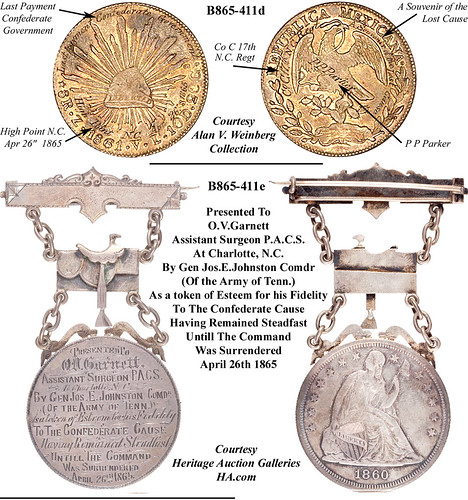
PREV ARTICLE
NEXT ARTICLE
FULL ISSUE
PREV FULL ISSUE
MORE ON ENGRAVED CONFEDERATE DAVIS FLIGHT MEDALS
My own favorite article from last week was the item from Nat Kaminski on his great-grandfather's engraved Mexican 8 Reales, a fascinating U.S. civil war item.
Here's a compilation of more information from E-Sylum readers.
First up is researcher and author Peter Bertram.
-Editor
You didn’t think you’d get this issue through without hearing from me, did you? I read with great interest the article in the March 30th E-Sylum about Mr. Nat Kaminski’s engraved Civil War era coin from his great-grandfather. I have images of several of these types of coins that will appear in my forthcoming book on Confederate material. I have labeled these engraved coins collectively as “The Davis Flight Medals” because they are inescapably bound to the flight, pursuit and capture of President Jefferson Davis. In a nutshell, here are some notes that may be of interest to Mr. Kaminski. By the first week in April, 1865, the Confederacy was collapsing. President Davis and the Confederate cabinet left Richmond by rail to attempt to relocate the Government further South. Probably of greater interest to Mr. Kaminski, however, is the Confederate Treasury, which was loaded onto a train and also sent South. The Treasury was estimated at $500,000 and consisted of Mexican 8 Reales (including Mr. Kaminski’s coin) and US. Silver Dollar coins in wooden kegs, U.S. gold $20 coins in boxes and two boxes of gold sovereigns, also ingots, nuggets, and silver bricks. Realize that at that time, the silver Mexican 8 Reales and US Silver Dollar coins were exchanged evenly at 1 for 1. The Treasury Dept train arrived at Danville, Virginia on April 3. They redeemed some Confederacy currency for silver coin at the rate of 70 to 1 and paid out unknown amounts for informal requisitions. On April 7 the Treasury (including Mr. Kaminski’s coin) left Danville and moved by rail through Greensboro, NC en route to Charlotte. As the Treasury train passed through Greensboro, it stopped briefly to leave behind $39,000 in silver coin (including Mr. Kaminski’s coin) to pay General J. E. Johnston's army, at the time near Raleigh, NC. The Treasury train then continued on to Charlotte. There’s obviously much more to the story but for now we’re mostly interested in following Mr. Kaminski’s coin. General J. E. Johnston surrendered his army on April 26 and his soldiers were paid from the funds left behind in Greensboro. General Beauregard would later recall that each man received about $1.15 and that he still had his share, “planning to have a small medal made of it as a memento of the last days of the Confederacy”. Mr. Kaminski’s coin is dated April 27 at Greensboro, NC which would have made his great-grandfather among the last men to be paid. Inscriptions on the other coins I’ve seen are mostly April 26, although one is dated April 25. At April 27 Mr. Kaminiski’s coin is the latest pay date I’ve seen. Earlier is, I suppose, possible but not likely – same with later. Most troops were paid at Greensboro, but I’ll also show specimens from High Point and Charlotte. As to the engraving on the coin: -“Camp Marion, SC” : After the war, Mr Kaminski’s great-grandfather joined the United Confederate Veterans (formed in 1890). The veterans were organized into “Camps” and he was a member of UCV Camp 641, Camp Marion, located in Marion, SC. In 1903 the Camp Commander was G.A. McIntyre, and the Adjutant was E. H. Gasque. -“1861 / initials BK? / 1865” : Years of his service, 1861-1865, and I assume his initials in center - “27th April Greensboro, NC” : date and where he was paid and mustered out Lastly, Mr. Kaminski very astutely notes “… I suspect very few of the surviving coins are alike, having been engraved at different locations with different markings according to the owner's wishes.” I agree and likewise don’t believe these pieces were engraved in April of 1865. The Confederacy was in its death throes at the time and normal commerce was virtually non-existent. Much more likely is that the veterans had the clothes on their backs and their Army pay. Some of them saved their silver dollar size coin and had it engraved years later. With his UCV Camp name engraved on the coin, it’s certainly true in this case!
Nat's family has given permission to publish the photos of their coin in Peter's upcoming book. Fantastic! Matchmaking is the fun part of the E-Sylum editor's job. What a great way to advance numismatic research. Below is Nat Kaminski's response.
-Editor
In Mr. Dunkerly's book, The Confederate Surrender at Greensboro, published in 2013 (available through Google play), he is fairly clear that the $37,679 in silver coins that ended up being distributed to the Confederate soldiers, was supposed to be sent on to President Davis in Charlotte and was not intended for the soldiers encamped around Greensboro. Here's how he describes it:
"Johnston performed one more act of defiance against Davis's wishes. The Confederate treasury had $37,679.96 in Mexican silver coins, and Davis had directed that it be sent on to him in Charlotte. Instead, on April 28th, Johnston's men were paid $1.17 each, and records indicate 32,174 were present. It was distributed as evenly as possible, with every seventh man getting an extra one." pp. 129-31 Your research seems to point to a different story where President Davis and the Confederate cabinet intended for those Mexican coins to be distributed to Johnston's men. I wonder which version is correct? I think it adds a bit of "pizazz" to the story if General Johnston distributed the money on his own volition. Also, with regard to the engraving on the front of my great grandfather's coin, the reference to "Camp Marion" is pointing to where he enlisted on July 19, 1861. This is described in a wonderful little book written by Lt. Col C.I Walker which documents the course of the war for the 10th Regiment S.C. Volunteers which was my great grandfather's regiment. He describes on p. 71 the formation of the regiment:
"The Regiment with the exception of the Coast Guards and Company K. (which last was ordered to Bull's Bay,) assembled in Camp of Instruction at Camp Marion, White's Bridge, near Georgetown, S.C., July 19th, 1861" The actual location of Camp Marion is unclear, but there is an effort to discover its exact whereabouts. Anyway, I think that is the more accurate understanding of the reference to Camp Marion and the date engraved on the coin. Peter Bertram adds: Four of the Davis Flight Medals relating to the Confederate Army payout at Greensboro are in Alan Weinberg's collection.
To view Alan Weinberg's Civil War medals, see:
www.neocollect.com/coll/65/

From Peter Bertram's book To read the earlier E-Sylum article, see: QUERY: ENGRAVED CONFEDERATE CAMP MARION COIN INFO SOUGHT (www.coinbooks.org/esylum_v17n13a15.html)

Wayne Homren, Editor The Numismatic Bibliomania Society is a non-profit organization promoting numismatic literature. See our web site at coinbooks.org. To submit items for publication in The E-Sylum, write to the Editor at this address: whomren@gmail.com To subscribe go to: https://my.binhost.com/lists/listinfo/esylum All Rights Reserved. NBS Home Page Contact the NBS webmaster 
|